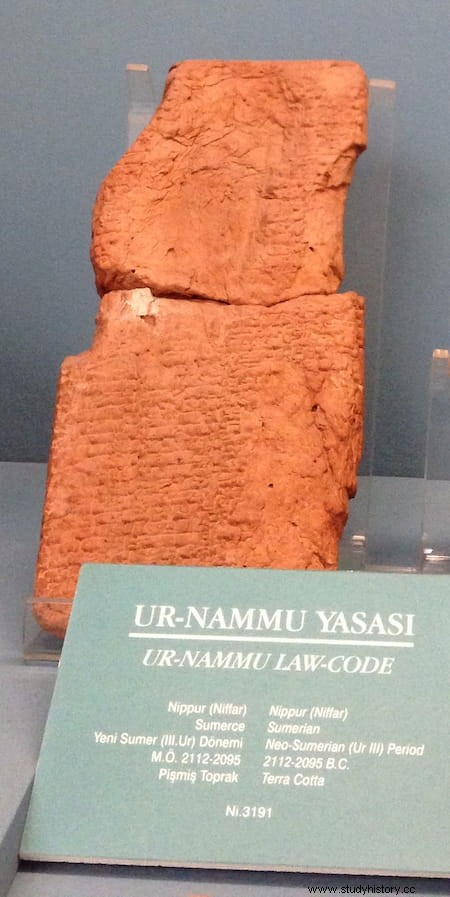Some of the earliest legal codes were formulated in the ancient Middle East. The Sumerians, Babylonians, Assyrians, Elamites, Hurrians, Kassites, and Hittites all had their own laws. Among them, the Code of Hammurabi is perhaps the best known, but there have been many earlier codes of law.
The first legal code of Mesopotamia was the Urukagina Code, written in the 24th century BC. However, no cuneiform tablet with that text has yet been discovered. We only know of its existence through references in other ancient works.
The oldest surviving legal code is the Code of Ur-Nammu, which was written about 300 years before Hammurabi's code. It was published under King Ur-Nammu of Ur (2112-2095 BC), although some historians think it was actually published by his son Shulgi, after the king's death.

The first copy of the code was found in two fragments at Nippur, and was translated by Samuel Kramer in 1952. Due to its partial preservation, only the prologue and 5 of the laws could be distinguished. Other tablets were found in Ur in 1965 and translated, allowing some 30 of the 57 laws to be reconstructed. Another copy found in Sippar contains slight variants.
Kramer later recalled how luck had favored him in finding the tablets:
The code begins with a prologue detailing how the moon god Nanna chose Ur-Nammu as king of Ur, helped him defeat the city of Larsa, and endowed him with laws according to which all subjects were considered equal regardless of their social status, so that the orphan would not fall prey to the rich, the widow would not fall prey to the powerful, the man of one shekel would not fall prey to the man of sixty shekels . The laws were framed in the if-this-then-that conditional format, a pattern followed in almost all subsequent codes. For example:

Almost all crimes carry monetary compensation, including bodily harm, as opposed to the eye for an eye principle. of many of the later Babylonian laws.
Under Hammurabi's code, if you gouged out another man's eye, he paid with one of his own and the same with a tooth.
In the Ur-Nammu code, however, theft, adultery, or rape were capital offenses and punishable by death. The same if someone took the life of another, he paid with his own.
The code gives us an idea of the social structure during the third dynasty of Ur, as well as allows us to know the issues that were considered important for the society of the time. Below the lugal or king, all members of society belonged to one of two basic strata:the lu or free person, or the slave.
The son of a lu her name was dumu-nita until he married, becoming a young man (gurus ). The woman (munus ) went from being a daughter (dumu-mi ) to wife (dam ) and, if she outlived her husband, a widow ( nu-ma-su ), who could remarry.
Who was Ur-Nammu?
Ur-Nammu was the founder of the third Sumerian dynasty of Ur, in southern Mesopotamia, after two hundred years of Akkadian and Gutu rule. The Akkadian Empire ruled Mesopotamia from 2334 BC. until 2083 BC, until he was overthrown by the Gutis, who descended from the Zagros mountains. However, the Gutis proved to be poor rulers.

Being an illiterate and nomadic people, his government did not favor agriculture or record keeping, and the region suffered from severe famine and rising grain prices. The Gutis were eventually defeated by a coalition of rulers from Uruk and Ur, and Utu-hengal of Uruk declared himself Sumer's first native king.
In the seventh year of his reign, Utu-hengal tragically died in an accident and was succeeded by his son-in-law, the governor of Ur, Ur-Nammu, who proceeded to found the Third Dynasty of Ur. Ur-Nammu became famous as a warrior king when he defeated the ruler of Lagash in battle. After this battle, Ur-Nammu earned the title of king of Sumer and Akkad .
Ur's rule over the Neo-Sumerian Empire was consolidated with the writing of the Code of Ur-Nammu, considered the first legal code of Mesopotamia since that of Urukagina of Lagash centuries earlier. Ur-Nammu was also responsible for ordering the construction of several ziggurats, including the Great Ziggurat of Ur.
This article was published on Amusing Planet. Translated from English and published with permission.
